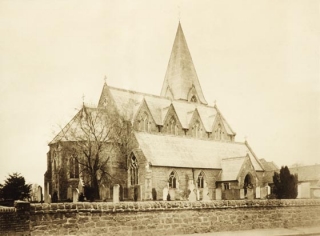It is believed that the origins of the church are in the 15th Century. The earliest part that remains is the tower and the font. The Victorian architects Hine and Evans rebuilt the rest between 1859 and 1860 after a fire, which destroyed the earlier, smaller building.
We can trace our history with the help of the board showing the vicars from 1529, which is on the south wall as you come into the Church. It’s recorded that on the 15th June 1527 a church, or more likely, a Chapel of Ease, was consecrated on the order of no less a figure than Cardinal Wolsey.
However, these were troubled times as in September 1552 Edward VI ordered the removal of many of the furnishings. An extract from a document of the times records:
“Bells in the stepl
Lynnen alter cloths
Chayles (chalice) of silver
Playn towels
Cruettes of pewter
Pyx of silver
Handbells
Cross of copper gylte
Vestments of silk with alb
Vestments of silk of carnation colour
With alb and a cope bleu satyn”
Generations of worshippers have over the years contributed to the furnishings and beautifying of the Church. The organ was the gift of the Misses Wilkins as was the carved screen in the West End. The bells were re-hung in 1890 and again in 1933. A sixth bell was given by Mrs Murdoch in 1974.
The chiming apparatus for the bells was a gift of Mrs. Cash and her son in 1909. Benefactors, too numerous to mention by name, have provided stained glass windows, carpets, altar furnishings, line plate, flower stands, hymns books, tables and the old painting of Our Lord. This hangs at the back of the church on the part of the original tower, which is now inside rather than outside!
In 1880 the Rev Whitelegge and his family gave the present clock “going eight days, having two days and striking the quarters”. This has now been updated with an additional two faces to mark the Millennium.
It’s interesting to note that Church expenses in 1848 were met by a Church rate of 3 halfpence in the pound levied on all inhabitants and parishioners. In 1851 the rate was raised to 2 1/2pence in the pound. In 1855 it was abolished and Church expenses met by the letting out of the lane verges for grazing.
The Local Government Act of 1894 changed the administration of parish affairs and the Churchwardens were no longer civil officers and only able to transact ecclesiastical business.
In 1982 the parish undertook a massive fund raising campaign to raise £60,000. Our efforts were rewarded. We were able to re-roof the Church, decorate, carpet and install new heaters.
To mark the millennium the church was fitted with floodlights and an exquisite quilt worked by ladies of the village depicting its history was given to the church and now hangs on the north wall inside the church.
See also Southwell and Nottingham Churches History here
